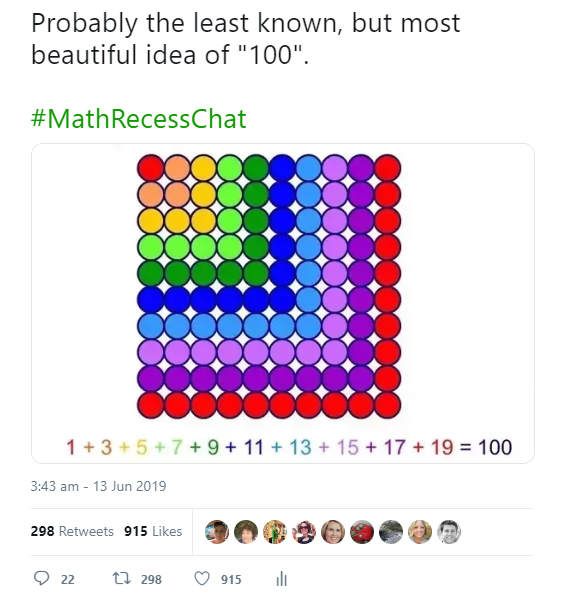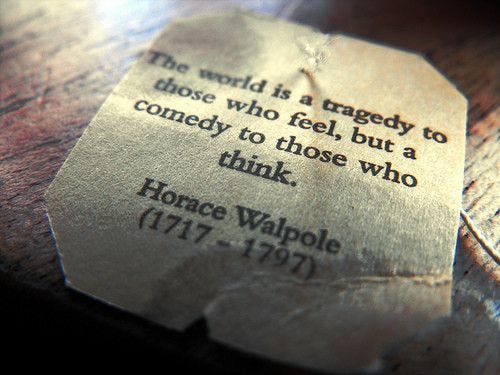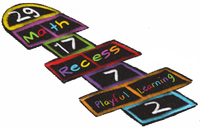On the morning of June 13, I tweeted out a picture of a 10 x 10 square of dots.
To be honest, I wasn’t expecting much engagement. I mean 10 x 10 equals a hundred and the summation of consecutive odd numbers forming squares is a pretty common visual. But, I was slightly smitten by the colors, and the running total of the odds below the picture served as a nice complement to the “L-shaped” array of colored dots.
Still, it shouldn’t have garnered the engagement numbers that it did in less than a week.

Did I miss something? Obviously I did. But what? There is no detailed lesson plan. This isn’t a big slice of mathematics to ponder. There is no question lurking around. It was simply a sharing of a math fact.
But, this math fact hit a collective nerve of awe, joy, and wonder in what even the simplest ideas of mathematics can bring.
It’s not hard to love mathematics. It’s just hard to love it in school.
But, let’s be honest, LOVE is not a goal of K to 12 mathematics. It might be a byproduct of proficiency, or talking a good game on social media and at math conferences, but if we were to be brutally honest, it is not a mandate to be inked into textbooks and mission statements.
We know, deep down inside, that inasmuch as we want our students to love mathematics, the conditions that are provided — controllable or not — are not amiable to any longevity of loving mathematics. Just because we love teaching mathematics doesn’t necessarily translate into students loving mathematics.
We have to love mathematics or be in the process of loving mathematics for that to occur — well, at least be given a better chance.
And, the response to the picture above proves that we do love mathematics. Imagine starting a class writing this one the board:
19 + 17 + 15 + 13 +…
Starting with “19” would further displace students from thinking that the summation of these odd numbers to “1” would add to the highly familiar of number, 100. Imagine doing this same activity with elementary kids, and then showing them that “this 100” is in the shape of square.
Do you know how excited they would be? Do you realize how much they would lose their minds?
Well, I can tell you. I did this activity with Grade 1 students five years ago. You would have thought by the expression on their faces that I was a magician. Well, in many ways I was. Not because of me, but because of mathematics. It has that allure. It has that seduction. There is almost something primal in our reaction to the slow unfolding of mathematical beauty.
It is timeless. It is ageless.
But square numbers are just the tip of the iceberg of number theory. And, number theory is just the tip of the iceberg algebra. And algebra is the just the tip of the iceberg of mathematics. For reasons that are somehow permanently lodged in a industrialized mindset of education, learning mathematics is a journey to be endured and to survive.
It is a loveless marriage, with no option for divorce, because society says you need **it**. Well, what **it** is, is long forgotten by almost all years later. We never forget the people that we love. Which probably explains why most of us have the blurriest of memories of math class.
Love? Pffft. We seem to be okay with a sizeable chunk of students exiting the system hating mathematics.
Two days after my post, Jo Boaler made a post that courageously called out for imagining how mathematics should be taught — as art.

Mathematics is art. It is society that is artless, pilfering and mining mathematics for applications, advantages, and an assortment of undeniably anemic topics. Our hearts don’t get drawn towards factoring, compound interest, and SOHCAHTOA. Our hearts get drawn towards beauty — often simple — that is emblematic of what is everlasting and transcending about mathematics.
The short game. Small ball. Not interested. The factory production model that produces conservative and perfunctory mathematical baubles and trinkets is carrying so much 20th century rust that if it wasn’t tragic, it would be laughable.

We need to be wildly in love with mathematics, and give our students the same opportunity to have fluttering hearts. And, that will only happen if we treat mathematics with the respect and admiration it deserves — to treat it and revere it like art, poetry, or music.
If not, we will continue to be ministers marrying the dreariest of mathematical ideas with loveless partners.
Dan Finkel, who has one of the most watched TED Talks on mathematics, and who graciously wrote the foreword for our book, “Math Recess: Playful Learning in an Age of Disruption”, created the website Math for Love for this simple reason — what better reason would you have to learn it other than love?
None.

Recent Comments